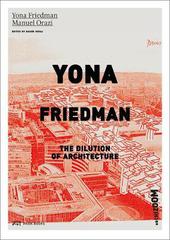
|
Yona Friedman. The Dilution of Architecture
Paperback / softback
Main Details
| Title |
Yona Friedman. The Dilution of Architecture
|
| Authors and Contributors |
By (author) Yona Friedman
|
|
By (author) Manuel Orazi
|
| Physical Properties |
| Format:Paperback / softback | | Pages:592 | | Dimensions(mm): Height 238,Width 174 |
|
| Category/Genre | Individual architects and architectural firms |
|---|
| ISBN/Barcode |
9783906027685
|
| Classifications | Dewey:720.92 |
|---|
| Audience | |
|---|
|
Publishing Details |
| Publisher |
Park Books
|
| Imprint |
Park Books
|
| Publication Date |
26 August 2015 |
| Publication Country |
Switzerland
|
Description
Yona Friedman is recognised as one of the most eminent proponents of 1960s avant-garde urbanism. His best-known work is the concept for a Spatial City ("La Ville Spatiale", 1956), in which he aimed to provide maximum flexibility through "megastructures" over existing cities and other locations. Inhabitants were meant to design their dwellings within these structures. Friedman sought to provide people in every part of the world with the knowledge and fundamental structures to determine their own environment for living and to enhance their independence and self-reliance. This new book offers a unique collection of brief texts and annotations as well as an abundance of images, sketches, drawings, watercolours etc. by Friedman himself. It also features a vast range of documents related to his work. In part II, Manuel Orazi gives an analysis of Friedman's oeuvre, based on extensive research. He follows the architect's progress through disciplinary and geographic areas apparently remote from one another, in which Friedman has been moving erratically and incessantly. Orazi also expands on historical, social and political contexts.A documentation of Friedman's intellectual relationships and other resources, an interview with Swiss architect Bernard Tschumi about Friedman, and a comprehensive bibliography round out the book.
Author Biography
Yona Friedman, born 1923, studied architecture at Budapest University of Technology and Economics. After having escaped capture and deportation from Hungary by the Nazis during World War II, he lived in Israel for nearly ten years where he completed his education at the Technion - Israel Institute of Technology in Haifa and also worked as a builder to earn his living. He has been living and working in Paris since 1957. Manuel Orazi took his PhD in history of architecture at Ca'Foscari University of Venice in 2007. He is an editor with Quodlibet publishers in Macerata and teaches theory and history of contemporary architecture at the universities of Bologna and Ferrara. He also regularly contributes to books and magazines.
|